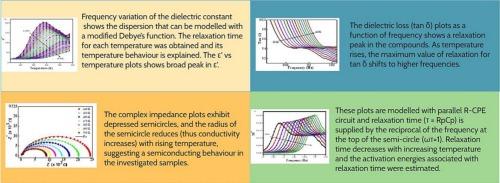On the question of relaxation time, its activation energies, and conduction mechanism of NiFe2-xLuxO4 (x@0, 5, and 7.5 %)
IF 4.6
3区 材料科学
Q2 MATERIALS SCIENCE, MULTIDISCIPLINARY
引用次数: 0
Abstract
We report the dielectric, impedance spectroscopic, and conductivity properties of NiFe2-xLuxO4 (x@ 0, 5, and 7.5 %) samples. The frequency dependence of the dielectric constant is explained using Koop's phenomenological theory, showing dispersion, which is modeled using a modified Debye function, considering contributions from multiple ion relaxation processes. Complex impedance plots display depressed semicircular arcs, with the radius decreasing as the temperature rises, indicating enhanced conductivity and a semiconducting nature in the samples. Impedance spectroscopy further reveals the presence of distinct relaxation mechanisms, distinguishing the contributions of bulk grains and grain boundaries to the overall electrical resistivity (Rg) and capacitance (Cg). Temperature-dependent AC conductivity measurements unveiled an overlapping large polaron tunnelling model, indicating a change in the conduction mechanism with temperature. The DC conductivity in the temperature range of 100 K to 300 K showed charge carriers' thermally activated drift mobility.

关于NiFe2-xLuxO4的弛豫时间、活化能和传导机理(x@0, 5, 7.5%)
我们报告了NiFe2-xLuxO4 (x@ 0、5和7.5%)样品的介电、阻抗光谱和电导率特性。使用Koop的现象学理论解释了介电常数的频率依赖性,显示了色散,色散使用修改的Debye函数建模,考虑了多个离子弛豫过程的贡献。复杂阻抗图显示,随着温度的升高,半圆弧半径减小,表明样品的导电性增强,具有半导体性质。阻抗谱进一步揭示了不同弛豫机制的存在,区分了大块晶粒和晶界对总体电阻率(Rg)和电容(Cg)的贡献。温度相关的交流电导率测量揭示了一个重叠的大极化子隧穿模型,表明了传导机制随温度的变化。在100 ~ 300 K温度范围内的直流电导率显示了载流子的热激活漂移迁移率。
本文章由计算机程序翻译,如有差异,请以英文原文为准。
求助全文
约1分钟内获得全文
求助全文
来源期刊

Materials Science and Engineering: B
工程技术-材料科学:综合
CiteScore
5.60
自引率
2.80%
发文量
481
审稿时长
3.5 months
期刊介绍:
The journal provides an international medium for the publication of theoretical and experimental studies and reviews related to the electronic, electrochemical, ionic, magnetic, optical, and biosensing properties of solid state materials in bulk, thin film and particulate forms. Papers dealing with synthesis, processing, characterization, structure, physical properties and computational aspects of nano-crystalline, crystalline, amorphous and glassy forms of ceramics, semiconductors, layered insertion compounds, low-dimensional compounds and systems, fast-ion conductors, polymers and dielectrics are viewed as suitable for publication. Articles focused on nano-structured aspects of these advanced solid-state materials will also be considered suitable.
 求助内容:
求助内容: 应助结果提醒方式:
应助结果提醒方式:


